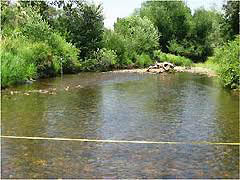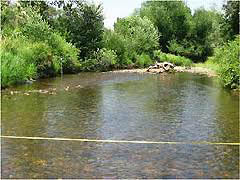By Rob Harmon
Energy and Natural Resource
Policy Expert
Edited Transcript
There are tens of thousands of miles of dewatered streams in the United States. On this map, the colored areas represent water conflicts. Similar problems are emerging in the East as well. The reasons vary state to state, but mostly in the details. There are 4,000 miles of dewatered streams in Montana alone. They would ordinarily support fish and other wildlife. They’re the veins of the ecosystem, and they’re often empty veins.
I want to tell you the story of just one of these streams because it’s an archetype for the larger story. This is Prickly Pear Creek. It runs through a populated area from East Helena to Lake Helena. It supports wild fish including cutthroat, brown and rainbow trout. Nearly every year for 
The problem is that all over the West now it looks like this. Some of these creeks have claims for 50 to 100 times more water than is actually in the stream. And the senior water rights holders, if they don’t use their water right, they risk losing their water right, along with the economic value that goes with it. So they have no incentive to conserve. So it’s not just about the number of people; the system itself creates a disincentive to conserve because you can lose your water right if you don’t use it. So after decades of lawsuits and 140 years now of experience, we still have this. It’s a broken system. There’s a disincentive to conserve, because, if you don’t use your water right, you can lose your water right. And I’m sure you all know, this has created significant conflicts between the agricultural and environmental communities.
Okay. Now I’m going to change gears here. Most of you will be happy to know that the rest of the presentation’s free. And some of you’ll be happy to know that it involves beer. (Laughter) There’s another thing happening around the country, which is that companies are starting to get concerned about their water footprint. They’re concerned about securing an adequate supply of water, they’re trying to be really efficient with their water use, and they’re concerned about how their water use affects the image of their brand. Well, it’s a national problem, but I’m going to tell you another story from Montana, and it involves beer. I bet you didn’t know, it takes about 5 pints of water to make a pint of beer. If you include all the drain, it takes more than a hundred pints of water to make a pint of beer.
Now the brewers in Montana have already done a lot to reduce their water consumption, but they still use millions of gallons of water. I mean, there’s water in beer. So what can they do about this remaining water footprint that can have serious effects on the ecosystem? These ecosystems are really important to the Montana brewers and their customers. After all, there’s a strong correlation between water and fishing. And for some, there’s a strong correlation between fishing and beer. (Laughter) So the Montana brewers and their customers are concerned, and they’re looking for some way to address the problem.
So how can they address this remaining water footprint? Remember Prickly Pear. Up until now, business water stewardship has been limited to measuring and reducing, and we’re suggesting that the next step is to restore. Remember Prickly Pear. It’s a broken system. You’ve got a disincentive to conserve, because if you don’t use your water right, you risk losing your water right. Well, we decided to connect these two worlds — the world of the companies with their water footprints and the world of the farmers with their senior water rights on these creeks. In some states, senior water rights holders can leave their water in-stream while legally protecting it from others and maintaining their water right. After all, it is their water right, and if they want to use that water right to help the fish grow in the stream, it’s their right to do so. But they have no incentive to do so.
So, working with local water trusts, we created an incentive to do so. We pay them to leave their water in-stream. That’s what’s happening here. This individual has made the choice and is closing this water diversion, leaving the water in the stream. He doesn’t lose the water right, he just chooses to apply that right, or some portion of it, to the stream, instead of to the land. Because he’s the senior water rights holder, he can protect the water from other users in the stream. Okay? He gets paid to leave the water in the stream.
This guy’s measuring the water that this leaves in the stream. We then take the measured water, we divide it into thousand-gallon increments. Each increment gets a serial number and a certificate, and then the brewers and others buy those certificates as a way to return water to these degraded ecosystems. The brewers pay to restore water to the stream. It provides a simple, inexpensive and measurable way to return water to these degraded ecosystems, while giving farmers an economic choice and giving businesses concerned about their water footprints an easy way to deal with them.
After 140 years of conflict and 100 years of dry streams, a circumstance that litigation and regulation has not solved, we put together a market-based, willing buyer, willing seller solution — a solution that does not require litigation. It’s about giving folks concerned about their water footprints a real opportunity to put water where it’s critically needed, into these degraded ecosystems, while at the same time providing farmers a meaningful economic choice about how their water is used.
These transactions create allies, not enemies. They connect people rather than dividing them. And they provide needed economic support for rural communities. And most importantly, it’s working. We’ve returned more than four billion gallons of water to degraded ecosystems. We’ve connected senior water rights holders with brewers in Montana, with hotels and tea companies in Oregon and with high-tech companies that use a lot of water in the Southwest. And when we make these connections, we can and we do turn this into this.
AUTHOR
Taking the true measure of our environmental footprint is something that Rob Harmon has been doing for years. Starting as an energy auditor in Massachusetts, Harmon went on to manage an international marketing effort in the wind energy industry and, in 2000, develop and launch the first carbon calculator on the Internet. Learn more.



